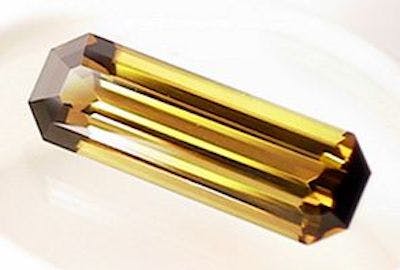Gram Easy Emerald: Online Faceting Designs & Diagrams
Easy to cut, the Gram Easy Emerald by Jeff Graham will maximize gem yield. This design and its cutting sequence will also accommodate stones with arbitrary length to width ratios.
1 Minute Read
You can find cutting instructions for the Gram Easy Emerald here.
Cutting Remarks
First, cut the stone to a rectangular outline, then follow with two courses of pavilion steps. The P5 steps on the second course are cut in until the width across the face of the P3 facets on the first course is reduced to approximately 0.227W, where W is the width of the stone. Thus, if you have a 10 mm wide stone, cut in P5 until the width of P3 reduces to 2.27 mm. (0.227 x 10 mm = 2.27 mm). At both ends, of course.
You can use an inexpensive pair of calipers to make that measurement, but it need not be exact. You could even determine it by "calibrated eyeball." However, the closer the width of P3 comes to 0.227W, the closer your corners will come to matching the relative proportions shown in the three views.
Corner Facet Notes
Establish the width of the corners (12, 36, 60, and 84) by cutting the P6(G) facets through the girdle to meetpoints at the bottom of the first step. The lower portion of P6(G) is subsequently overcut at 72° by P7, creating the pavilion girdle line on the corners. The wider you leave P3, the wider and deeper the corner facets. I cut the yellow tourmaline in the photo with the width of P3 approximately equal to 0.300W. Note how its table is cut through the C4, C5, and C6 meetpoints, with the effect of adding embellishing bevels at the table corners and making it larger.
Pavilion Notes
The pavilion ends (24, 72) are relatively steep to help keep from darkening or mixing muddy colors on the c-axis and to improve yield. For darker materials, you could tangent ratio the crown to reduce its depth. In most cases, however, I would rather have the dispersion of the deeper crown.
The P3 outer pavilion facets light up when you rock the stone, and the P5 and P10 inside blink. This gives the classic "emerald" look that I prefer.
Enjoy cutting your Gram Easy Emerald.
Detailed faceting instructions by Jeff Graham available at The Rock Peddler
Jeff R. Graham
The late Jeff Graham was a prolific faceter, creator of many original faceting designs, and the author of several highly-regarded instructional faceting books such as Gram Faceting Designs.
Related Articles
Emerald Value, Price, and Jewelry Information
Seven Famous Emeralds and Their Stories
Emerald Origins: History and Identification
Emerald Transformation: Cleaning and Recutting a Natural Emerald
Latest Articles
Precision Faceting a Story Gemstone: Choosing Rough
32 Green Gemstones (How Many Do You Know?)
A Guide to Antique Georgian Jewelry
Hambergite Value, Price, and Jewelry Information
Never Stop Learning
When you join the IGS community, you get trusted diamond & gemstone information when you need it.
Get Gemology Insights
Get started with the International Gem Society’s free guide to gemstone identification. Join our weekly newsletter & get a free copy of the Gem ID Checklist!
